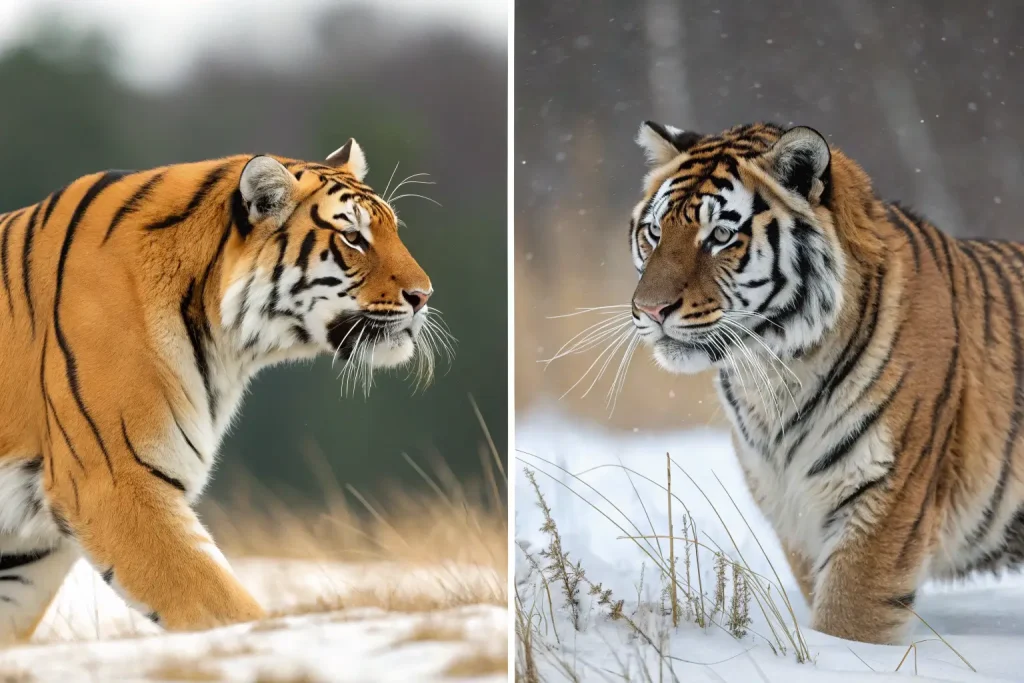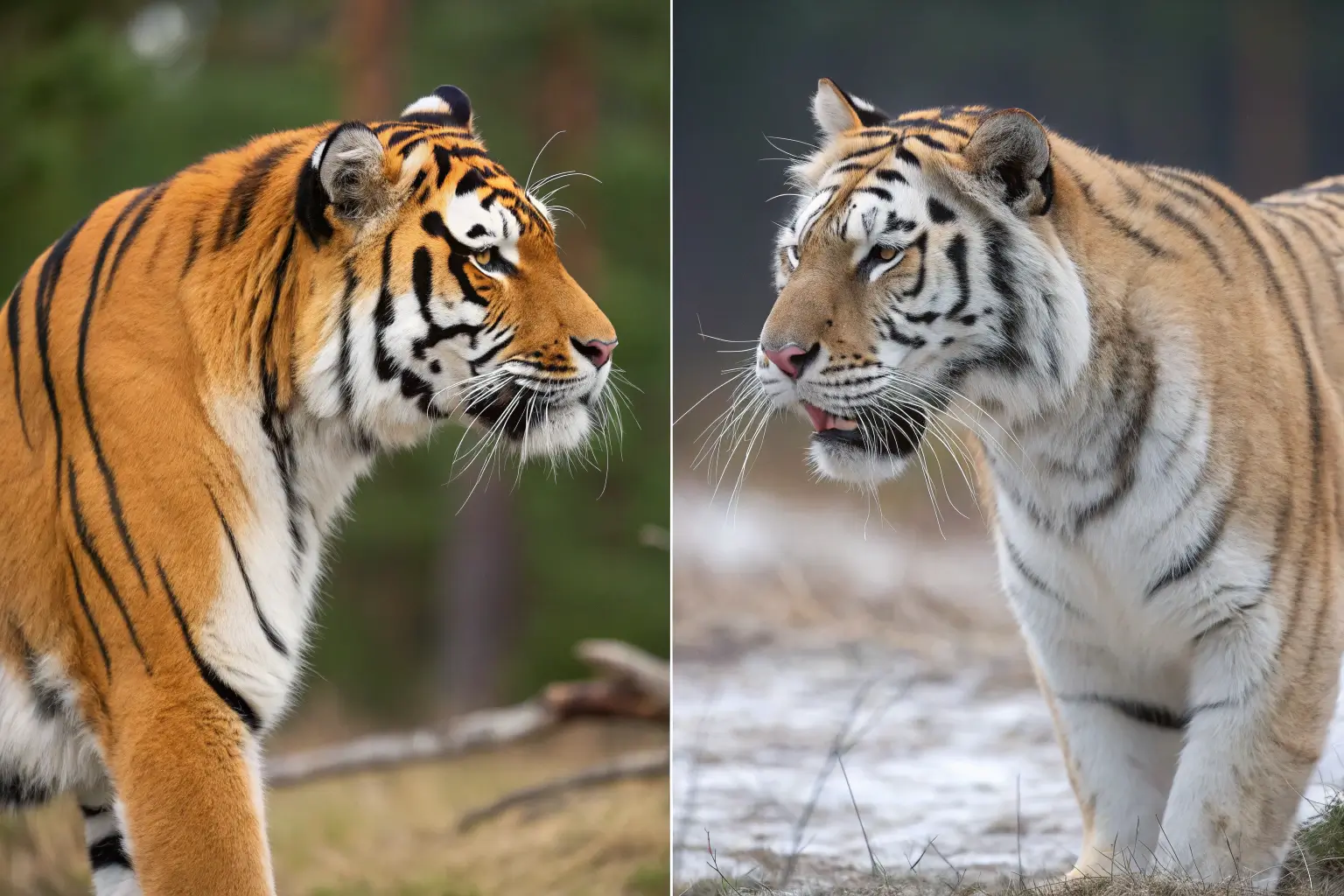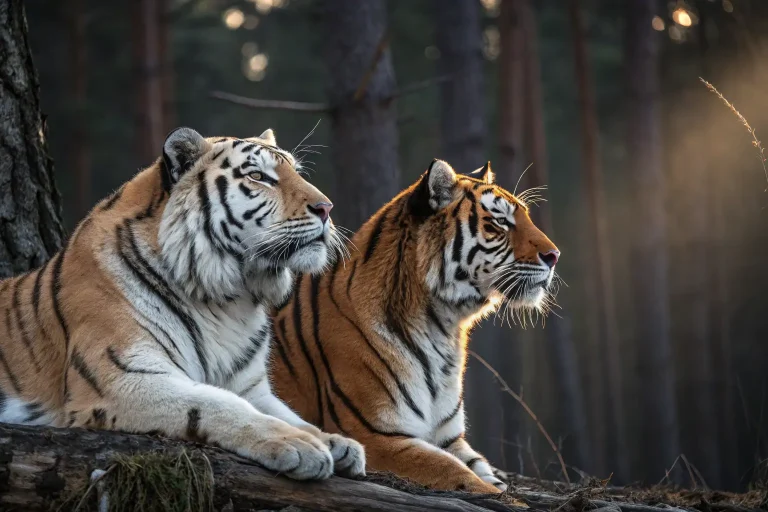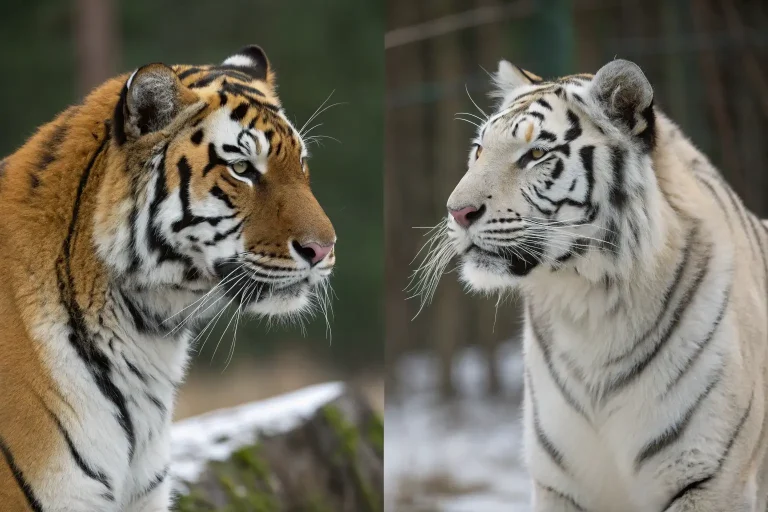Bengal Tiger vs Siberian Tiger: 7 Key Differences Explored
Are you fascinated by the world’s most magnificent big cats? The bengal tiger vs siberian tiger comparison reveals contrasting adaptations, behaviors, and survival strategies between these two apex predators. While they share the same species classification of Panthera tigris, these majestic subspecies have evolved distinct characteristics shaped by their unique environments. This comprehensive guide explores seven crucial differences between these iconic felines, from their physical attributes to their conservation challenges.
Introduction
The tiger, nature’s perfect predator, represents power, majesty, and ecological balance across its range. Understanding the differences between the bengal tiger vs siberian tiger isn’t merely academic—it reveals evolution’s remarkable adaptability and highlights conservation priorities for each subspecies.
Imagine standing in a humid Bengal forest as a streak of orange and black flashes between the trees, while across continents, another tiger treads silently through snow-covered Siberian forests. Same species, drastically different worlds.
Did you know that despite being separated by thousands of miles, both tigers can interbreed and produce fertile offspring? Yet their distinct environments have sculpted them into uniquely adapted subspecies with fascinating differences.
Species Overview
Scientific Classification
Both tigers belong to the Panthera tigris species, but are classified as different subspecies:
- Bengal Tiger: Panthera tigris tigris
- Siberian Tiger: Panthera tigris altaica (also known as Amur tiger)
The bengal tiger represents the most numerous tiger subspecies, while the siberian tiger claims the title for the largest of all tiger subspecies.
Physical Characteristics
When comparing the bengal tiger vs siberian tiger, size differences immediately stand out. Siberians typically weigh between 400-675 pounds (180-306 kg) for males, with exceptional individuals exceeding 700 pounds. Bengal males generally weigh 400-550 pounds (180-250 kg).
The bengal tiger displays a vibrant orange coat with distinctive black stripes and a white underbelly. Its pigmentation appears more intense compared to the siberian tiger, which exhibits a paler orange-yellow coat with fewer, sometimes brown-tinged stripes. Siberian tigers grow notably thicker fur with longer hair—an essential adaptation for their frigid habitat.
Their skull structures differ subtly too, with Siberians possessing larger cranial volumes relative to body size, supporting enhanced sensory processing for hunting in snow-covered environments.
Subspecies Variations
The bengal tiger includes several regional populations, including the critically endangered Royal Bengal tigers of the Sundarbans. The siberian tiger historically ranged from Eastern Russia to parts of China and the Korean Peninsula, though its distribution has significantly contracted.
A key difference in the bengal tiger vs siberian tiger comparison involves genetic diversity. The bengal tiger maintains greater genetic variation, while siberian tigers experienced severe genetic bottlenecks during 20th-century population crashes, resulting in lower genetic diversity.
Habitat and Distribution
Natural Habitat
The bengal tiger thrives in diverse ecosystems across the Indian subcontinent, including:
- Tropical and subtropical moist broadleaf forests
- Mangrove swamps (Sundarbans)
- Grasslands and savanna
- Dry deciduous forests
In stark contrast, the siberian tiger inhabits:
- Temperate broadleaf and mixed forests
- Coniferous boreal forests (taiga)
- Rugged mountainous terrain
- Birch forest ecosystems
This fundamental habitat difference shapes nearly every aspect of the bengal tiger vs siberian tiger comparison.
Geographic Range
The bengal tiger primarily inhabits:
- India (home to approximately 70% of the population)
- Bangladesh
- Nepal
- Bhutan
- Parts of Myanmar
The siberian tiger’s range includes:
- Russian Far East (Primorsky Krai and Khabarovsk Krai regions)
- Small populations in northeastern China
- Possibly isolated individuals in North Korea
The bengal tiger’s range spans approximately 140,000 square miles, while the siberian tiger’s territory covers roughly 70,000 square miles—significantly reduced from its historical distribution.
Adaptations
Environmental pressures have created remarkable differences between these subspecies:
The bengal tiger possesses:
- More compact, muscular build for ambush hunting in dense vegetation
- Water affinity and swimming ability (especially in the Sundarbans)
- Heat tolerance with physiological cooling mechanisms
- Higher population density capabilities
The siberian tiger has evolved:
- Thicker subcutaneous fat layer (up to 2 inches)
- Larger body size following Bergmann’s rule (increased body mass helps retain heat)
- Broader paws functioning like natural snowshoes
- Longer, denser winter coat with insulating hollow guard hairs
These adaptations highlight how the bengal tiger vs siberian tiger comparison reveals evolutionary responses to dramatically different environmental challenges.
Diet and Feeding Habits
What They Eat
Both subspecies are obligate carnivores, but their prey selection differs significantly in the bengal tiger vs siberian tiger comparison:
Bengal tigers primarily hunt:
- Sambar deer
- Chital (spotted deer)
- Gaur (Indian bison)
- Wild boar
- Nilgai antelope
- Water buffalo
- Occasionally domestic livestock
Siberian tigers target:
- Manchurian wapiti (elk)
- Sika deer
- Wild boar
- Moose
- Musk deer
- Smaller prey including rabbits and salmon during scarce periods
The size difference between subspecies reflects their prey availability—Siberian tigers evolved larger bodies partly to take down bigger prey animals in environments with fewer overall prey options.
Hunting Behavior
The bengal tiger typically hunts through:
- Short, explosive ambush attacks
- Strategic use of cover in dense vegetation
- Nocturnal and crepuscular hunting patterns
- Territory maintenance through regular patrolling
The siberian tiger employs:
- Patient stalking over longer distances
- Strategic use of landscape features
- Highly developed snow tracking abilities
- Larger territories reflecting sparser prey density
A fascinating bengal tiger vs siberian tiger hunting difference involves kill frequency. Bengals typically make a large kill every 8-10 days, while Siberians might go 10-14 days between major kills due to prey scarcity, compensating by consuming more of each carcass.
Dietary Needs
Both subspecies require approximately 10-15 pounds of meat daily when averaged across time. However, the siberian tiger faces seasonal extremes requiring consumption of up to 50 pounds after a kill, followed by days without feeding.
The bengal tiger benefits from year-round prey availability, while the siberian tiger must adapt to pronounced seasonal fluctuations—sometimes traveling over 1,000 square kilometers to find sufficient food during harsh Siberian winters.
Behavior and Social Structure
Social Behavior
In the bengal tiger vs siberian tiger comparison, social dynamics show significant similarities:
- Both are predominantly solitary animals
- Males maintain larger territories overlapping with several females
- Territorial boundaries marked through scent marking, scratching, and spraying
However, notable differences exist:
- Bengal tigers maintain smaller territories (20-60 square miles for males)
- Siberian tigers require vast ranges (up to 450 square miles for males)
- Bengal tigers show higher tolerance for proximity to other tigers
- Siberian tigers display extreme territoriality reflecting scarce resources
Communication
Both subspecies use similar communication methods:
- Vocalizations (roars, moans, hisses)
- Scent marking through spraying urine and feces
- Visual signals through body posture and facial expressions
The bengal tiger vs siberian tiger communication comparison reveals that Siberians may vocalize less frequently—possibly an adaptation to conserve energy in their harsher environment. Bengals communicate more actively due to higher population densities requiring clearer territorial boundaries.
Mating and Reproduction
Reproductive patterns show several key differences:
Bengal tigers:
- Can breed year-round
- Average 2-3 cubs per litter
- Sexual maturity at 3-4 years
- Reproductive cycles less affected by seasonal changes
Siberian tigers:
- Primarily mate January through June
- Average 2-4 cubs per litter (occasionally 5-6)
- Slightly later sexual maturity (4-5 years)
- Higher cub mortality in particularly harsh winters
Female bengal tigers may reproduce more frequently throughout their lifetime compared to siberian tigers, whose reproductive output faces greater environmental constraints.
Conservation Status

Endangerment Level
The bengal tiger vs siberian tiger conservation situation presents different challenges:
Bengal tiger:
- IUCN Status: Endangered
- Population: Approximately 2,500-3,000 individuals
- Population trend: Stable to slightly increasing in protected areas
Siberian tiger:
- IUCN Status: Endangered
- Population: Approximately 500-550 individuals
- Population trend: Stable but vulnerable to fluctuations
While bengal tigers outnumber siberians, both face significant extinction threats without continued conservation efforts.
Threats
Bengal tigers primarily face:
- Habitat fragmentation and loss
- Poaching for traditional medicine
- Human-wildlife conflict
- Prey depletion
- Climate change affecting the Sundarbans habitat
Siberian tigers contend with:
- Poaching for fur and body parts
- Prey depletion from illegal hunting
- Logging of old-growth forests
- Low genetic diversity
- Infrastructure development fragmenting habitat
The bengal tiger vs siberian tiger threat assessment suggests bengals face greater direct human pressure due to higher human population density, while siberians face severe challenges from smaller population size and genetic bottlenecks.
Conservation Efforts
Conservation strategies differ between subspecies:
For bengal tigers:
- Project Tiger (India’s flagship conservation program)
- Trans-boundary cooperation between India, Nepal, and Bangladesh
- Anti-poaching patrols and community involvement
- Corridor restoration to connect fragmented populations
- Compensation schemes for livestock loss
For siberian tigers:
- Russian-Chinese cooperation on transboundary conservation
- Establishment of protected areas like Sikhote-Alin Reserve
- Anti-poaching brigades
- Prey species restoration
- Long-term population monitoring
The bengal tiger vs siberian tiger conservation approach highlights that bengals benefit from established conservation infrastructure, while siberian conservation relies heavily on international cooperation across vast, remote territories.
Interesting Facts
The siberian tiger’s roar can be heard up to 3 miles away and can paralyze prey with fear momentarily.
Bengal tigers in the Sundarbans regularly swim between islands and have adapted to drinking saltwater—something most other tiger populations cannot do.
In the bengal tiger vs siberian tiger strength comparison, Siberians possess the strongest bite force of any big cat—approximately 1,000 pounds per square inch.
The bengal tiger includes a rare color variant—the white tiger—resulting from a recessive gene. This mutation doesn’t occur in siberian tigers.
Siberian tigers can leap up to 19.5 feet horizontally and 12 feet vertically—remarkable for such a large animal.
Bengal tigers have been known to imitate the calls of prey animals to lure them closer, showing remarkable intelligence.
The siberian tiger has larger paws relative to body size than any other cat, measuring up to 9 inches across—perfect for traversing snow.
Tips for Tiger Conservation Awareness
While neither the bengal tiger nor siberian tiger can be kept as pets, you can support their conservation through:
- Donating to reputable conservation organizations like WWF or WildCat Conservation Alliance
- Avoiding products containing tiger parts or derivatives
- Supporting sustainable tourism that benefits tiger conservation
- Educating others about the differences and challenges in bengal tiger vs siberian tiger conservation
- Reducing consumption of products linked to tiger habitat destruction
Conservation awareness helps address the unique challenges each subspecies faces.
Role in the Ecosystem
Ecological Importance
As apex predators, both tigers perform crucial ecological functions:
The bengal tiger:
- Controls ungulate populations preventing overgrazing
- Indirectly protects forest vegetation and structure
- Maintains healthier prey populations by culling weak individuals
- Creates ecological ripple effects benefiting smaller species
The siberian tiger:
- Regulates ungulate populations across vast territories
- Influences prey behavior and distribution patterns
- Creates carrion resources for numerous scavenger species
- Helps maintain the integrity of temperate forest ecosystems
The bengal tiger vs siberian tiger ecological comparison reveals that both fulfill similar functional roles but across dramatically different ecosystems.
Impact of Decline
The loss of either subspecies would create severe ecological consequences:
Without bengal tigers:
- Ungulate overpopulation would damage forest ecosystems
- Competitive release could alter mesopredator populations
- Cultural and economic impacts on ecotourism
- Loss of one of India’s national symbols
Without siberian tigers:
- Disruption of predator-prey dynamics in boreal forests
- Potential cascading effects on vegetation communities
- Loss of evolutionary adaptations developed over thousands of years
- Cultural impact on indigenous Siberian peoples who revere the tiger
Conclusion
The bengal tiger vs siberian tiger comparison reveals nature’s remarkable adaptability. From the dense jungles of India to the snow-covered forests of the Russian Far East, these magnificent predators have evolved specialized traits while maintaining their essential tiger nature.
Both subspecies face uncertain futures requiring different conservation approaches—bengals need habitat connectivity and human conflict resolution, while siberians require international cooperation and protection from poaching. By understanding their differences, we gain deeper appreciation for their specialized adaptations and can better focus conservation efforts.
The fate of these magnificent cats rests in human hands. Every conservation success story begins with understanding, appreciation, and action. Whether through donations, educational outreach, or sustainable choices that protect wild habitats, each of us can contribute to ensuring these two remarkable tiger subspecies continue to thrive in their unique environments for generations to come.
Frequently Asked Questions
Which is bigger: the Bengal tiger or the Siberian tiger?
The Siberian tiger is generally larger than the Bengal tiger. Male Siberians typically weigh 400-675 pounds (180-306 kg), while male Bengals average 400-550 pounds (180-250 kg). This size difference evolved as an adaptation to the Siberian tiger’s colder environment, following Bergmann’s rule where animals in colder climates develop larger bodies to conserve heat.
Could a Bengal tiger survive in Siberia?
A Bengal tiger would struggle to survive in Siberia without the specialized adaptations of its Siberian cousin. Bengals lack the thick winter coat, substantial fat layer, and broader paws that help Siberian tigers navigate and survive in snow and sub-zero temperatures. Bengals evolved for tropical and subtropical environments, making Siberian winters potentially fatal for them.
Which tiger subspecies is more endangered?
While both are endangered, the Siberian tiger faces a more precarious situation with only 500-550 individuals remaining in the wild, compared to 2,500-3,000 Bengal tigers. Siberians also suffer from lower genetic diversity due to historical population bottlenecks. However, Bengals face more intense human pressure due to higher human population densities throughout their range.
Do Bengal and Siberian tigers have different hunting techniques?
Yes, their hunting techniques differ based on their environments. Bengal tigers typically rely on short, explosive ambush attacks in dense vegetation, while Siberian tigers often employ patient stalking over longer distances in more open forest terrain. Siberians have also developed specialized techniques for hunting in snow, including tracking prey through deep snowdrifts.
Can Bengal tigers and Siberian tigers interbreed?
Yes, Bengal and Siberian tigers can interbreed and produce fertile offspring because they belong to the same species, Panthera tigris. However, such hybridization doesn’t occur naturally due to geographical separation. In captivity, subspecies hybridization sometimes happens, though conservation programs typically avoid mixing subspecies to preserve their unique genetic adaptations.
What are the main threats to Bengal and Siberian tigers?
Bengal tigers primarily face habitat fragmentation, poaching, human-wildlife conflict, and prey depletion. Siberian tigers contend with poaching for fur and body parts, prey depletion from illegal hunting, logging of old-growth forests, and infrastructure development. Climate change increasingly threatens both subspecies, particularly affecting the Sundarbans habitat of Bengal tigers through rising sea levels.
How do climate adaptations differ between Bengal and Siberian tigers?
Bengal tigers have evolved for heat tolerance with physiological cooling mechanisms and lighter coats, along with swimming abilities particularly in the Sundarbans population. Siberian tigers display cold-weather adaptations including thicker fur with insulating hollow guard hairs, a substantial fat layer up to 2 inches thick, and larger paws that function as natural snowshoes in deep snow.





